
It had been an intense year of work and study. I desperately needed a break.
So I packed a backpack and went hiking with a group of friends. We did the sorts of things you see people do in wilderness films: we swam in rivers, slept under the stars, and ate the simplest of meals.
Five days later, I re-emerged from the forest feeling re-energised and with a new perspective. I felt excited about life again.
If you’ve ever skipped a holiday or used your holidays to catch up on work, you know at some level this is bad for your soul.
Research shows people who skip holidays are more likely to:
• suffer from burnout;
• feel emotionally exhausted;
• be less productive;
• have trouble concentrating during their free time after work; and
• find it harder to deal with the challenges of work, study, and life.
Think of the last time you felt really exhausted. How easy was it for you to do your work?
With a tired mind, it’s hard to get anything done. You can’t do your best work.
Let’s face it . . .
You’re not a machine.
You’re a human being.
Your energy is finite.
You have limits.

Following any period of intense or stressful work, you need to rest and recover.
If you choose to ignore your biological limits and burn yourself out, it can take 12 months to fully recover. It’s your choice. Your call. Personally, I wouldn’t risk it.
So it’s time to get serious about rest and in particular, holidays.
Let’s take a quick look at the science . . .
Research by Sabine Sonnentag and her team found we need to experience the following four things to fully recover from stress:
1) Relaxation;
2) Mental detachment from work;
3) A sense of being in control; and
4) Mastery experiences.
In his book Rest: Why You Get More Done When You Work Less, Alex Soojung-Kim Pang encourages us to think of breaks as being like meals. You want your meal (i.e. your break) to be nourishing, so it needs to be high in all four of the components listed above.
The good news is you can train yourself to get better at doing these four things. It just takes practice.
Below we explore each of these factors in more detail. Read on!
This is about calming your mind and body.
What’s the best way to relax?
There are no hard and fast rules but you could try:
• Meditating;
• Having a massage;
• Listening to relaxing music;
• Spending time in nature;
• Doing yoga;
• Breathing exercises; and
• Taking a long hot bath.
What do these activities have in common?
They require very little effort. And they make you feel good!
Research by Frederickson (2001) found that when people feel good (i.e. they experience positive emotions) this helps to boost their energy levels.
Have you ever found yourself worrying about school/work when you weren’t at school/work?
When you do this, you’re wasting your precious (and finite) mental energy. But what’s even worse is that no recovery can occur when you worry.
One study by Sonnentag, Binnewies and Mojza (2008) found that low psychological detachment from work in the evening is associated with feeling exhausted and tired in the morning.
Want to wake up feeling refreshed and alert? Then stop any negative thoughts about work and school as soon as you get home.
Easier said than done, right?
Again, it’s just practice.
Here are some strategies that help me to switch off from my work/study:
• Set a worry time (worry o’clock): Find yourself worrying? Quickly jot down the thought that is bothering you. Then tell yourself you’ll revisit that thought later at worry o’clock.
• Create non-work zones in your room/home: Deliberately segment work and off-work life. Don’t bring any work into your non-work areas.
• Don’t do any work on your holidays: Put your books and notes away. Your top priority is to have fun, relax and engage in mastery experiences (see point 4 below).
• Get moving: Engaging in intense physical exercise can provide ‘time out’ from worrisome thoughts. When I exercise, my focus is just on doing each movement (nothing else). I tune into how my body feels. Increased levels of endorphins, serotonin, and dopamine following exercise also help with the recovery process.
Do you feel in control of your time when you’re not at school or work? Can you engage in activities that you enjoy and find meaningful?
If the answer is no, you need to work on feeling more in charge of your life.
Here are some questions to consider:
• Are you overscheduled?
• Could you cut back on a few activities/commitments to free up more time for fun and relaxation?
• Can you outsource any activities?
• Can you do certain activities more efficiently to free up more time?
• Can you reduce time confetti in your life?
These are experiences that challenge and stretch you in some way. When you engage in them, you tend to forget about your work and/or school.
These activities require you to exert a bit of effort, but you don’t want them to leave you feeling completely exhausted.
Here are some examples of mastery experiences:
• Physical exercise;
• Learning a new instrument (e.g. the piano);
• Learning a foreign language;
• Volunteering in the community; and
• Taking a free online course on a topic that interests you.
As a general rule of thumb, try to limit time on digital devices over the holidays.
Let me be clear: technology can be a great tool to help you engage in a mastery experiences. But depending on how you use it, it can also inhibit the recovery process.
Screen time leisure activities, such as scrolling on your phone and watching Netflix, don’t really challenge us. We typically sit down and enter a passive, zombified state. This in turn can lead to boredom, apathy and depression.
For every hour you spend in front of a screen, that’s an hour you could have spent at the beach, going for a walk in nature, working on a creative project or learning how to cook a new dish.
Here’s another reason to limit your screen time . . .
If you’re looking at a screen 30 minutes before going to bed, you’re messing with your melatonin (a hormone that makes you feel sleepy). The light emitted from screens has been shown to suppress the production of melatonin, thereby making it harder for people to fall asleep.
Scrolling through your social media feed so close to bedtime also means you’re at risk of seeing content that upsets you.
Put simply . . .
As Demerouti and her team state:
“The better an individual’s physiological and psychological state before bedtime, the longer and better the quality of sleep she/he will have. A better quality and quantity of sleep in turn leads to a better psychological and energetic state the next morning before going to work.”
So put your phone to bed at least 30 minutes before you plan on going to bed. This simple action could change both your mood and outlook in dramatic and profound ways.
For these holidays, I encourage to explore and experiment with different ways to make your break truly restorative. And most importantly, make sleep your top priority.
Share This:

Most of us do. We sit and stare at our screens or textbooks for large chunks of the day.
You’ve probably heard the phrase, “Sitting is the new smoking”. It sounds dramatic, but sitting for 30 minutes or more leads to:
• Reduced blood flow to the brain
• Increased blood pressure
• Increased blood sugar
• Reduced positive emotions
Even if you exercise at the gym, if you sit all day at work or school, that’s not good for you.
Most of us know we should move more and sit less, but knowledge doesn’t always translate into action.
I’ve known for years about the harms of sitting. Every year, I’d set a goal “To move more during the day”. But it wasn’t until this year that I finally got off my butt and started taking regular movement breaks. In this blog, I’ll share what made all the difference.
Part of my problem was telling myself to “move more” and “sit less”. This was way too vague for my brain.
When it comes to taking movement breaks, how long should we move for? How frequently? And at what intensity?
I recently came across a brilliant study, published in 2023, that answered some of these questions.
A team of researchers at Columbia University compared different doses of movement on several health measures (e.g., blood sugar, blood pressure, mood, cognitive performance, and energy levels).
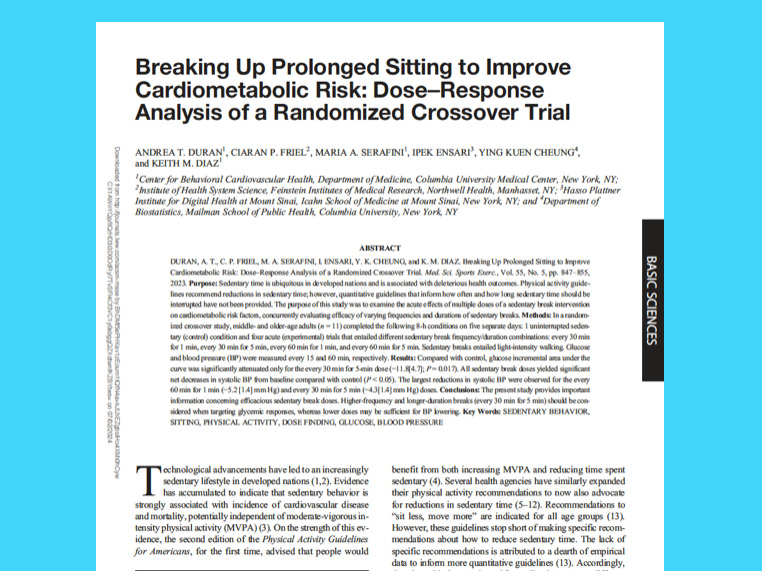
The researchers were interested in exploring how often and for how long we need movement breaks to offset some of the harms of sitting for long periods.
So, what did they do in this study?
Researchers brought participants into the lab and made them sit in an ergonomic chair for 8 hours. Participants could only get up to take a movement break or go to the toilet.
They tested five conditions:
• Uninterrupted sedentary (control) condition (Note: no movement breaks)
• Light-intensity walking every 30 minutes for 1 minute
• Light-intensity walking every 30 minutes for 5 minutes
• Light-intensity walking every 60 minutes for 1 minute
• Light-intensity walking every 30 minutes for 5 minutes
The optimal amount of movement was five minutes every 30 minutes. This movement dose significantly reduced participants’ blood sugar and blood pressure and improved their mood and energy levels.
That said, even a low dose of movement (one minute of movement every 30 minutes) was found to be beneficial.
Although walking has been described as ‘gymnastics for the mind’ and numerous studies show brisk walking can improve cognitive performance, they found no significant improvements in participants’ cognitive performance in this particular study.
You can read the full study here.
When it comes to any research conducted in the lab, the question worth asking is: Is it possible for people to do this in the real world? And if so, will they experience similar benefits?
Journalist Manoush Zomorodi wanted to find out. So, she teamed up with Columbia University researchers to explore whether people could incorporate regular five-minute movement breaks into their day.
They created a two-week challenge where people could sign up to one of three groups:
1) Five-minute movement breaks every 30 minutes
2) Five-minute movement breaks every hour
3) Five-minute movement breaks every two hours
Over 23,000 people signed up to participate in the challenge. Sixty per cent completed the challenge.
What did they find?
Five-minute movement breaks improved people’s lives, whether taken every half hour, hour, or two hours. They felt less tired and experienced more positive emotions.
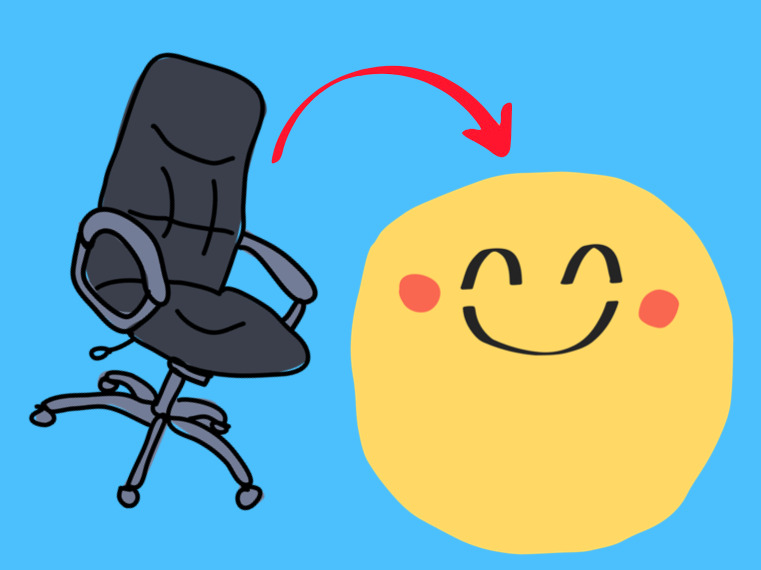
They found a dose-response relationship. This meant that the more frequently people moved, the more benefits they gained.
In the Body Electric podcast, Columbia University researcher Dr Keith Diaz said a preliminary analysis of the data showed:
• People who moved every 30 minutes improved their fatigue levels by 30%.
• People who moved every hour improved their fatigue levels by 25%.
• People who moved every 2 hours improved their fatigue levels by 20%.
Here’s the thing, though . . .
Dr Diaz pointed out that most people weren’t getting all their exercise breaks in. On average, they took eight movement breaks each day (note: the researchers recommended 16 movement breaks a day), but they still experienced benefits.
Here’s what I take from all of this . . .
You don’t have to do this perfectly. There are no hard and fast rules. Doing some movement is better than doing no movement.
All movement matters. It all adds up.
Although movement is natural and good for the mind and body, my brain often resists the thought of getting up and moving (“No! I don’t want to get out of this cosy chair!”).
What’s up with that?
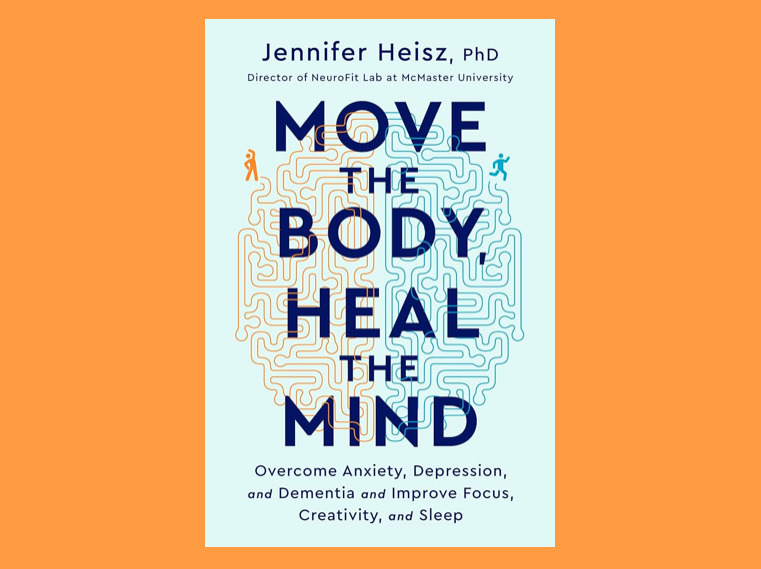
In the book Move the Body, Heal the Mind, Dr Jennifer Heisz explains that our brains hate exercise for two reasons:
1) The brain doesn’t want to expend energy; and
2) Exercise can be stressful.
This has to do with how our brains are wired and our deep evolutionary programming.
If we go back in time, our hunter-gatherer ancestors had to be constantly on the move to gather food, build shelter and run from hungry animals. All of this activity required a lot of energy. Since food was scarce and energy was limited, hunter-gatherers had to conserve their energy.
If you were to offer a hunter-gatherer a free meal and a comfortable place to stay, would they take it? You bet they would.
The problem is our brains haven’t changed in thousands of years. We still have the same brain wiring as our ancient ancestors.
This is why my brain often throws a tantrum and comes up with all sorts of excuses to avoid my morning workout.
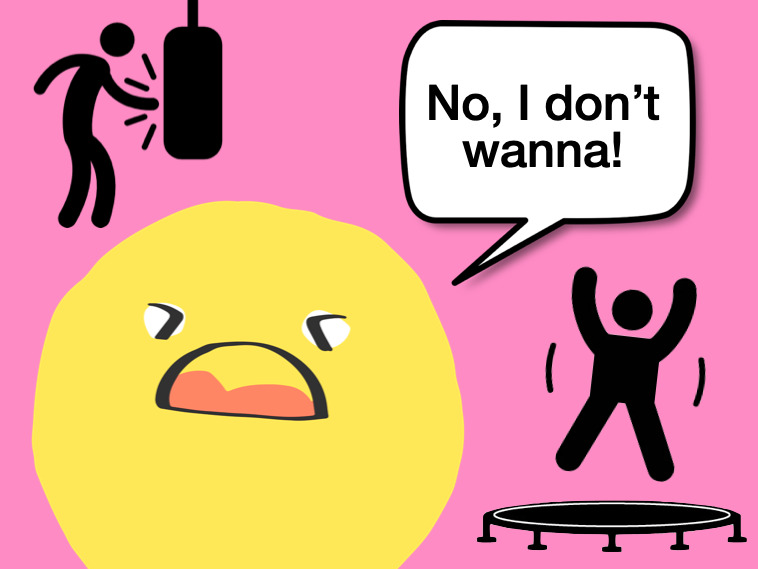
In this modern world, with all the calorie-dense fast food, comfy chairs, and modern conveniences, our brains get confused.
As evolutionary psychologist Dr Doug Lisle, author of The Pleasure Trap, states, in the modern world:
“What feels right is wrong. And what feels wrong is right.”
Understanding that we operate with an ancient brain that isn’t suited to this modern world opens up new possibilities. For example, you can use your prefrontal cortex (the rational part of your brain) to override the primitive instinct to stay comfortable.
Here are some strategies I’ve been experimenting with to get me taking regular five-minute movement breaks:
I’ve strategically placed electronic timers in every room I spend a lot of time in (e.g., my office, outdoor desk, and dining room). Before I sit down to start a task, I set a timer for 25 minutes.
When the timer goes off, that cues my brain to get up and move.
When the timer goes off, I usually jump on my treadmill for a five-minute walk. But not always.
Whenever I feel like doing something different, I play a little game with myself.
The game is simple:
I roll a dice with different movement activities I wrote on each side. Whatever activity it lands on, I do it.
Here are the activities currently listed on my dice:
• Pick up a set of dumbbells and do some bicep curls
• Do some stretches on my yoga matt
• Use resistance bands
• Go outside and walk around my garden
• Do squats
• Hit play on an upbeat track and dance!
Sometimes, the timer going off will not be enough to get you up and moving. You may need to have a few words with your brain.
I often find myself negotiating with my brain, trying to convince myself to get up and move.
Me: “Come on, it’s time to get up.”
Brain: “Noooo! It’s nice and comfy here.”
Me: “On the count of three, we’re going to do this . . . 1 . . . 2. . . 3.”
Be gentle with your brain. Remember, it’s wired for comfort.
There’s a reason I have stretch bands hanging on door knobs, a yoga mat rolled out on my dining room floor, a rack of dumbbells next to my desk, and comfortable walking shoes always on my feet. All of these little things make it easy for me to move.
Look around your workspace: is there anything that makes it hard for you to move? Identify any barriers and do what you can to remove them.
Instead of stopping to take a movement break, can movement become part of what you do?
For instance, I wrote the first draft of this blog as I walked at a slow pace on my treadmill desk, and I edited it while pedalling at my cycle desk.
Remember, movement doesn’t need to be strenuous to be effective. Light-intensity movement delivers results.
I recently finished reading an excellent book called Creative First Aid: The science and joy of creativity for mental health. It is packed full of creative practices to help calm your nervous system.
One of the practices the authors suggest is creating a playlist of songs called ‘I Dare You Not to Move’. This playlist is a selection of songs that make you want to dance.
On a movement break, I close my blinds and hit play on one of my favourite dance tracks.
Don’t consider yourself much of a dancer? No problem! Sway your hips from side to side or throw your hands in the air and make some circles with them.
Even though it may feel good in the moment to stay seated in a comfy chair, I have to regularly remind myself that movement makes me feel good (and less stiff and achy).
Remember, whenever we force ourselves to get up and move, we go against our brain’s programming. This is why these reminders are so important.
Before stepping onto the treadmill to do a run, I say to myself, “This is good for me. You won’t regret doing this”. And you know what? I always feel better after a workout.
What is something you already do on a regular basis?
It could be making a cup of tea, preparing lunch, or putting on your shoes.
According to the Tiny Habits Method, the key to forming habits is to attach a tiny behaviour to a pre-existing habit. For example:
• After I put on the kettle, I will do five wall push-ups.
• After I shut down my computer, I will do arm circles for 30 seconds.
• After I put my lunch in the microwave, I will march on the spot.
• After I pick up the phone, I will stand up to walk and talk.
• After I notice I am feeling sluggish, I will hit play on an upbeat song.

If you want to wire in this new movement break quickly, celebrate after moving your body (i.e. release a positive emotion). I tell myself, “Good job Jane!”. But usually, the movement leaves me feeling good, so it’s not always necessary.
The science is in. We know breaking up periods of sitting with regular five-minute movement breaks can make a big difference to our mental and physical health. The good news is you don’t even have to break a sweat to experience these benefits (light-intensity movement will do the job).
If you can’t manage moving every half hour, no problem. Do what you can. Some movement is better than no movement. On that note, is it time to get up and move? Let’s do this together. How about a light walk? Or a short dance break?
On the count of three . . . one . . . two . . . three. Let’s go!
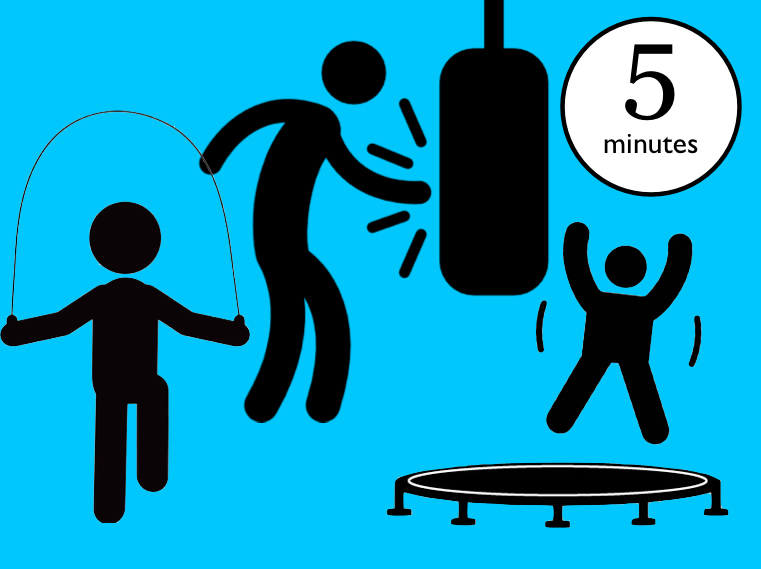
Here’s a simple thing you can do to help you focus better and improve your study sessions . . .
Take regular exercise breaks.
A study titled Sweat so you don’t forget found that engaging in regular five minute exercise breaks reduced mind wandering, improved focus, and enhanced learning.
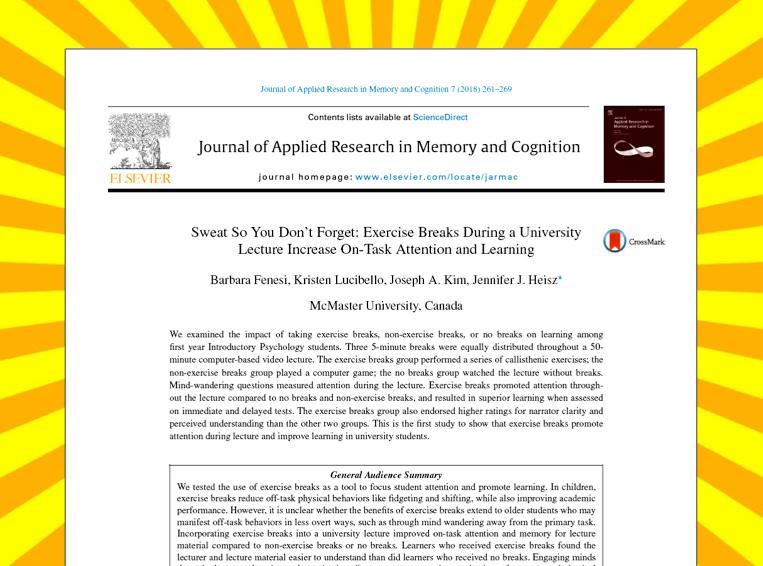
In this study the researchers wanted to know if engaging in short exercise breaks could help with learning.
They took a group of 75 psychology students and split them into three groups.
Group 1: Exercise breaks group
Group 2: Non-exercise breaks group
Group 3: No breaks group

All the students had to watch the same 50 minute psychology lecture. But the difference between the groups was this . . .
The exercise breaks group performed five minutes of exercise every 17 minutes. The non-exercise breaks group played a simple video game for five minutes every 17 minutes. The no breaks group had to watch the entire lecture without getting a single break.
The students in the exercise breaks group could focus better and they retained more information. They also found the lecturer easier to understand.
The researchers said:
“The exercise breaks buffered against declines in attention resulting in superior engagement during the latter part of the lecture compared to the other two groups.”
One would think they would show some improvements in attention and memory since they were getting breaks. But they didn’t show any significant improvements.
In fact, they performed just as well as the no breaks group in terms of attention and memory.
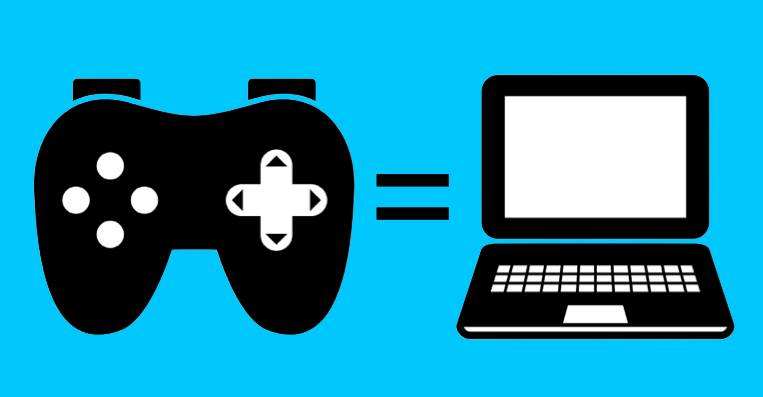
The researchers concluded:
“One possibility is that the computer game played during the non-exercise break may have acted as a second cognitive task as opposed to a cognitive break. Switching between two cognitive tasks can deplete attention and impair performance for both tasks.”
This shows the type of activity you engage in on a study break is really important. It pays to get out of your head and move your body!
It was a series of exercises performed for 50 seconds each followed by a rest break:
1) Jumping jacks (50 seconds) + Rest (10 seconds)
2) Heeltaps (50 seconds) + Rest (10 seconds)
3) High knees (50 seconds) + Rest (10 seconds)
4) Split jumps (50 seconds) + Rest (10 seconds)
5) Hamstring kickers (50 seconds) = The End
Since reading this study, I’ve started to incorporate more exercise breaks into my day and I’m noticing a big difference.
Personally, I’m not a fan of some of the exercises the researchers made the participants do in this study. So, I have replaced them with other cardio exercises I enjoy doing, such as punching a boxing bag and using a skipping rope.
I also find doing 50 seconds of non stop exercise pretty exhausting. For this reason, I’ve reduced my exercise time down to 40 seconds followed by a 20 second rest break. I find it helps to time my exercise sprints/rest breaks using an interval timer on my phone instead of a kitchen timer (which can feel a little clunky).
Feel free to experiment with different exercise/rest ratios. Make it work for you. As your fitness levels improve, you can increase the period of time you exercise for.
After working for 20 or 30 minutes, get up and take a five minute exercise break.
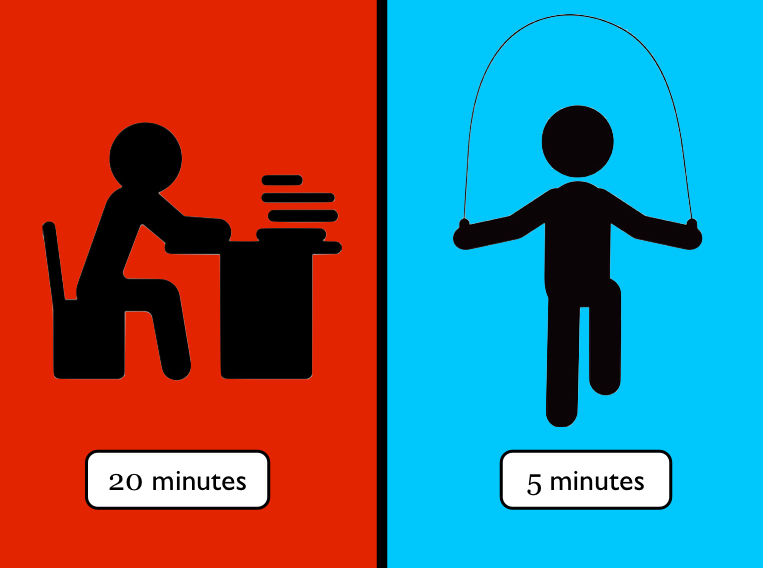
You don’t have to do jumping jacks or hamstring kickers. Select simple exercises you want to do.
Notice how you feel before and after your exercise break.
After experimenting with this simple strategy, I can say with confidence that I feel more energised and mentally sharper throughout the day. Try it and let me know how you go!
Many of us are sacrificing the quality of our lives by going too hard at living.
It’s drilled into us that in order to succeed, we need to be constantly working, striving towards our goals and improving ourselves.
Don’t get me wrong, I’m a big fan of self improvement. I’m all for doing things more effectively. But sometimes you need a little time out.
In team sports, coaches will often call ‘time out’ as a way to regroup, reflect and recharge.
But we’re not so good at taking time out for ourselves. And it costs us. There is plenty of research to show overwork is bad for your health (see here, here and here).
In the book The Inner Self: The joy of discovering who we really are, author Hugh Mackay describes busyness as being a health hazard. He states:
“ . . . it robs us of the sanity-restoring time for reflection on our inner life, and may even dull our awareness of the need for regular encounters with the self.”
Over the last few months, I’ve been engaging in an activity that allows me to slow down, take pleasure in small things and rest while still being somewhat productive.
It’s called pottering.
In the book Pottering: A cure for modern life author Anna McGovern describes pottering in the following way:
“Pottering is not glamorous. You don’t have to put too much effort in, go very far or even do it with others. Pottering is not a lifestyle concept, and it doesn’t require practice. Just be.
The consequence of pottering – a feeling of relaxation and contentment- is usually achieved when you make do with what you’ve got, get moving but don’t go too far, don’t try too hard and keep it digital free.”
Pottering allows you to recalibrate to a saner and healthier pace of life. It reminds you that there’s so much more to life than being productive.
When you potter, there’s no pressure to achieve results or a perfectly clean room/home. And there’s also no need to share your pottering experience on social media. That would defeat the purpose. Why? Because pottering requires you to take time out from screens.
What I love about pottering is you get to set the bar extremely low. In fact, you don’t have to accomplish much at all.
According to Anna McGovern, pottering involves adhering to the following five basic principles:
When you potter, there’s no need to rush out and buy new things. Pottering is about being resourceful. It’s about thinking on your feet and making do with what you’ve got.
For instance, instead of buying takeaway for lunch, you challenge yourself to pull together a meal with what you’ve got in your fridge and pantry. In some ways, pottering can be a very creative practice.
When you potter, there’s no where to get to. Nothing to achieve. The aim of the game is to slow down and enjoy doing one activity at a time.
McGovern offers this wisdom:
“Consider the words that define pottering ‘without definite plan or purpose’. Let those words really sink in . . . You have the freedom to make tea any way you like. You be you. No one is going to judge. It’s just you and the tea.”
Pottering doesn’t involve vigorous exercise but it usually involves simple movements like pulling things out from cupboards, rearranging items in rooms, folding clothes, filing away or tossing papers, etc.
You get to go with the flow. Let’s say you’re putting away an item and you stumble across something else that needs attending to (e.g. a drawer that need rearranging), you can change course. Remember, you don’t have to be efficient or productive when you potter.
All that being said, it’s also totally fine to plonk yourself down in a cosy chair and enjoy a cup of tea.
Pottering days are chill days. You are unauthorised to rush around. McGovern recommends you do things locally on your pottering days.
On my pottering days, I like to keep away from my car and use my bike and legs as transport. This helps me feel more connected to my local community. With the car off limits, this means I can’t travel very far. When I’m in full pottering mode, an epic journey is the local library.
It’s time to dial down the noise in your life and brain. Keeping away from your phone, Netflix and social media will help. As McGovern states:
“ . . . ignoring digital devices and limiting your access to them also means that you are not constantly bombarded with messages, information, unrealistic images of perfection and pictures of social occasions that you haven’t been invited to.”
McGovern recommends finding old-school alternatives for your phone for the times when you potter. She suggests using a calendar, alarm clock, radio, TV, a landline, newspapers, notepad and pen, map and cash.
Life is short. Don’t run yourself ragged trying to get ahead and be a productivity machine. Slow down. Take a day or afternoon off and give yourself the freedom and space to potter.
Dr Jane Genovese delivers interactive sessions on learning to learn, combating procrastination, exam preparation, how to focus in the age of distraction, habit formation and much, much more!
Get FREE study and life strategies by signing up to our newsletter:
© 2024 Learning Fundamentals